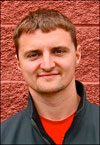Mike Bogdanor, a second year graduate student in civil and environmental engineering, has been awarded a 2013 National Defense Science and Engineering Graduate Fellowship through the Air Force Office of Scientific Research to continue his doctoral research.
The NDSEG fellowship is a highly competitive three-year award that pays full tuition and fees and offers a monthly stipend. It is awarded annually to only about 200 students who intend to pursue a doctoral degree in one of 15 supported disciplines.

Bogdanor, of Clarksville, Md., works with Caglar Oskay, assistant professor of civil and environmental engineering, on multiscale modeling and life prediction of composite materials in Oskay’s Multiscale Computational Mechanics Laboratory.
“I am very excited about the opportunity the NDSEG fellowship presents. This award will allow me to pursue research topics and directions that might not be available with current research projects. It also validates my current research trajectory and the utility of the research in areas that I am naturally drawn to,” said Bogdanor, who earned a bachelor’s degree in civil engineering from Villanova University.
Bogdanor will focus on how to reconcile failure phenomena at multiple scales.
“I will model rate-dependent damage evolution at the material scale. Then, I will model the transition of microcracks from the material scale to the macroscopic structural scale. This approach should greatly increase computational efficiency. Further analysis will account for sources of uncertainty at disparate scales in the material and propagate that uncertainty across the multiscale model. Combining these tools will improve accuracy in long term structural scale prediction,” said Bogdanor, whose doctoral thesis topic is “Life Prediction of Aerospace Composites Subjected to Cyclic Loading.”
A large part of the MCML research involves studies of failure rates of composite materials used in military aircraft, and the use of computer models to predict when materials might fail under extreme conditions.
“This fantastic opportunity will give Mike the ability to freely explore and advance the state-of-the-art in life prediction of heterogeneous structures as well as probabilistic multiscale computational mechanics. We are planning to combine our research group’s expertise with Mike’s considerable research acumen to significantly advance fundamental understanding in these areas, particularly as applied to defense sciences,” Oskay said.